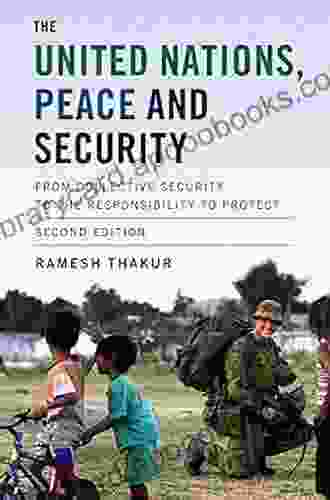From Collective Security to the Responsibility to Protect: A New Paradigm for Global Peace and Security

The Responsibility to Protect (R2P) is a global political commitment to prevent genocide, war crimes, crimes against humanity, and ethnic cleansing. It was adopted by the United Nations in 2005 and has since been endorsed by over 150 countries. R2P is based on the principle that every state has a responsibility to protect its own population from these crimes. If a state is unable or unwilling to do so, the international community has a responsibility to intervene to protect the population.
R2P represents a significant shift in the way the international community thinks about its responsibility to protect civilians. For much of the 20th century, the international community relied on the principle of collective security to prevent and respond to mass atrocities. Collective security is based on the idea that all states have a responsibility to work together to maintain international peace and security. However, collective security has often been ineffective in preventing mass atrocities, as states have been unwilling or unable to intervene in other countries to stop them.
R2P is a more proactive approach to preventing mass atrocities. It places the primary responsibility for protecting civilians on the state itself. However, it also recognizes that the international community has a responsibility to intervene if a state is unable or unwilling to protect its own population.
5 out of 5
| Language | : | English |
| File size | : | 1555 KB |
| Text-to-Speech | : | Enabled |
| Screen Reader | : | Supported |
| Enhanced typesetting | : | Enabled |
| Word Wise | : | Enabled |
| Print length | : | 428 pages |
R2P has been used to justify a number of international interventions, including the intervention in Libya in 2011. However, it has also been criticized by some states, who argue that it infringes on their sovereignty.
The origins of R2P can be traced back to the aftermath of the Holocaust. After the Second World War, the international community was determined to prevent such atrocities from ever happening again. In 1948, the United Nations adopted the Universal Declaration of Human Rights, which affirmed the inherent dignity and worth of all human beings. The Declaration also recognized that everyone has the right to life, liberty, and security of person.
In the years that followed, the international community developed a number of norms and mechanisms to protect civilians from mass atrocities. These included the Geneva Conventions, which prohibit the killing, torture, and other forms of mistreatment of civilians in wartime. The United Nations also established a number of peacekeeping missions to help protect civilians in conflict zones.
However, despite these efforts, mass atrocities continued to occur. In the 1990s, the international community failed to prevent the genocide in Rwanda and the Srebrenica massacre in Bosnia. These failures led to a reassessment of the international community's responsibility to protect civilians.
In 2001, the International Commission on Intervention and State Sovereignty (ICISS) was established to examine the issue of intervention in cases of mass atrocities. The ICISS concluded that the international community had a responsibility to intervene to protect civilians from genocide, war crimes, crimes against humanity, and ethnic cleansing. The ICISS also developed a set of principles for intervention, which included the principles of necessity, proportionality, and legitimacy.
The R2P doctrine was adopted by the United Nations in 2005. The R2P doctrine is based on the three pillars of prevention, protection, and response. The prevention pillar focuses on identifying and addressing the root causes of mass atrocities. The protection pillar focuses on protecting civilians from mass atrocities. The response pillar focuses on responding to mass atrocities when they occur.
The R2P doctrine is based on the following three pillars:
- Prevention: The prevention pillar focuses on identifying and addressing the root causes of mass atrocities. This includes promoting good governance, human rights, and the rule of law. It also includes providing early warning of potential mass atrocities and taking steps to prevent them from occurring.
- Protection: The protection pillar focuses on protecting civilians from mass atrocities. This includes providing physical protection to civilians, such as through peacekeeping missions and humanitarian assistance. It also includes providing legal protection to civilians, such as through the International Criminal Court.
- Response: The response pillar focuses on responding to mass atrocities when they occur. This includes taking action to stop the atrocities, such as through military intervention. It also includes providing assistance to victims of mass atrocities, such as through medical care and psychosocial support.
The R2P doctrine has been praised by many as a significant step forward in the protection of civilians from mass atrocities. However, it has also been criticized by some, who argue that it is too vague and that it could be used to justify intervention in sovereign states for reasons other than the protection of civilians.
One of the main challenges of R2P is defining what constitutes a mass atrocity. The R2P doctrine does not provide a clear definition of mass atrocity, and this has led to some states arguing that it could be used to justify intervention in cases that do not meet the criteria of genocide, war crimes, crimes against humanity, or ethnic cleansing.
Another challenge of R2P is determining when the international community has a responsibility to intervene. The R2P doctrine states that the international community has a responsibility to intervene when a state is unable or unwilling to protect its own population from mass atrocities. However, it does not specify what criteria should be used to determine when a state is unable or unwilling to protect its population.
The R2P doctrine also faces challenges in terms of implementation. The international community often lacks the resources and political will to intervene in cases of mass atrocities. This can make it difficult to implement the R2P doctrine effectively.
Despite the challenges, the R2P doctrine remains an important tool for the protection of civilians from mass atrocities. The doctrine has helped to raise awareness of the issue of mass atrocities and has led to a number of positive developments, such as the establishment of the International Criminal Court and the adoption of the Responsibility to Protect Act by the United States.
The future of R2P depends on the willingness of the international community to implement the doctrine effectively. The international community must be prepared to intervene in cases of mass atrocities, even when it is difficult or unpopular to do so. The international community must also be prepared to provide the resources and political will necessary to implement the doctrine effectively.
The R2P doctrine is a new and evolving doctrine. It is not a perfect doctrine, but it is a significant step forward in the protection of civilians from mass atrocities. The international community must continue to work to implement the R2P doctrine effectively in Free Download to prevent future mass atrocities.
The Responsibility to Protect (R2P) is a global political commitment to prevent genocide, war crimes, crimes against humanity, and ethnic cleansing. It was adopted by the United Nations in 2005 and has since been endorsed by over 150 countries. R2P is based on the principle that every state has a responsibility to protect its own population from these crimes. If a state is unable or unwilling to do so, the international community has a responsibility to intervene to protect the population.
R2P represents a significant shift in the way the international community thinks about its responsibility to protect civilians. For much of the 20th century, the international community relied on the principle of collective security to prevent and respond to mass atrocities. However, collective security has often been ineffective in preventing
5 out of 5
| Language | : | English |
| File size | : | 1555 KB |
| Text-to-Speech | : | Enabled |
| Screen Reader | : | Supported |
| Enhanced typesetting | : | Enabled |
| Word Wise | : | Enabled |
| Print length | : | 428 pages |
Do you want to contribute by writing guest posts on this blog?
Please contact us and send us a resume of previous articles that you have written.
 Book
Book Novel
Novel Page
Page Chapter
Chapter Text
Text Story
Story Genre
Genre Reader
Reader Library
Library Paperback
Paperback E-book
E-book Magazine
Magazine Newspaper
Newspaper Paragraph
Paragraph Sentence
Sentence Bookmark
Bookmark Shelf
Shelf Glossary
Glossary Bibliography
Bibliography Foreword
Foreword Preface
Preface Synopsis
Synopsis Annotation
Annotation Footnote
Footnote Manuscript
Manuscript Scroll
Scroll Codex
Codex Tome
Tome Bestseller
Bestseller Classics
Classics Library card
Library card Narrative
Narrative Biography
Biography Autobiography
Autobiography Memoir
Memoir Reference
Reference Encyclopedia
Encyclopedia Charlie Kaufman
Charlie Kaufman Thomas Abbott
Thomas Abbott Stephan Labossiere
Stephan Labossiere Andrea Maller
Andrea Maller Clive Forth
Clive Forth Aminatou Sow
Aminatou Sow Mary Waldorf
Mary Waldorf Amy J Heineke
Amy J Heineke Kyle Johnson
Kyle Johnson I J Parker
I J Parker Michael Mcalister
Michael Mcalister Amit Agrawal
Amit Agrawal Amy Sophiamehr
Amy Sophiamehr Julie Kagawa
Julie Kagawa Priscilla Royal
Priscilla Royal Nikki Walker
Nikki Walker Amber Adams
Amber Adams Thea Atkinson
Thea Atkinson Wendy Van De Poll
Wendy Van De Poll Amanda Rigby
Amanda Rigby
Light bulbAdvertise smarter! Our strategic ad space ensures maximum exposure. Reserve your spot today!

 Oscar WildeHow to Overcome the Loss of a Beloved Dog: A Healing Guide for the Grieving...
Oscar WildeHow to Overcome the Loss of a Beloved Dog: A Healing Guide for the Grieving...
 Brandon CoxThe Key to Confidently Trust Yourself: Unlock Your Inner Strength and Live a...
Brandon CoxThe Key to Confidently Trust Yourself: Unlock Your Inner Strength and Live a... Travis FosterFollow ·3.1k
Travis FosterFollow ·3.1k Damon HayesFollow ·7k
Damon HayesFollow ·7k Henry GreenFollow ·3.9k
Henry GreenFollow ·3.9k Josh CarterFollow ·6.9k
Josh CarterFollow ·6.9k Rick NelsonFollow ·19.5k
Rick NelsonFollow ·19.5k Benjamin StoneFollow ·16.4k
Benjamin StoneFollow ·16.4k Michael ChabonFollow ·13.5k
Michael ChabonFollow ·13.5k Chance FosterFollow ·11.5k
Chance FosterFollow ·11.5k

 Roald Dahl
Roald DahlImmerse Yourself in a Mesmerizing Tapestry of Creativity:...
Prepare to be captivated by "Spectra," an...

 Clarence Brooks
Clarence BrooksUnleash Your Inner Taylor with Red Piano Vocal Guitar:...
Embrace the Red Era...

 Jeffrey Hayes
Jeffrey HayesUnlock Your Child's Academic Potential: A Comprehensive...
In today's rapidly changing...

 William Golding
William GoldingBrave Elizabeth: A Captivating Tale of Resilience and...
Immerse Yourself in a Riveting Historical...

 Curtis Stewart
Curtis StewartUnveiling the Heartfelt Melodies of Taylor Swift: A...
Step into the enchanting world of Taylor...
5 out of 5
| Language | : | English |
| File size | : | 1555 KB |
| Text-to-Speech | : | Enabled |
| Screen Reader | : | Supported |
| Enhanced typesetting | : | Enabled |
| Word Wise | : | Enabled |
| Print length | : | 428 pages |










